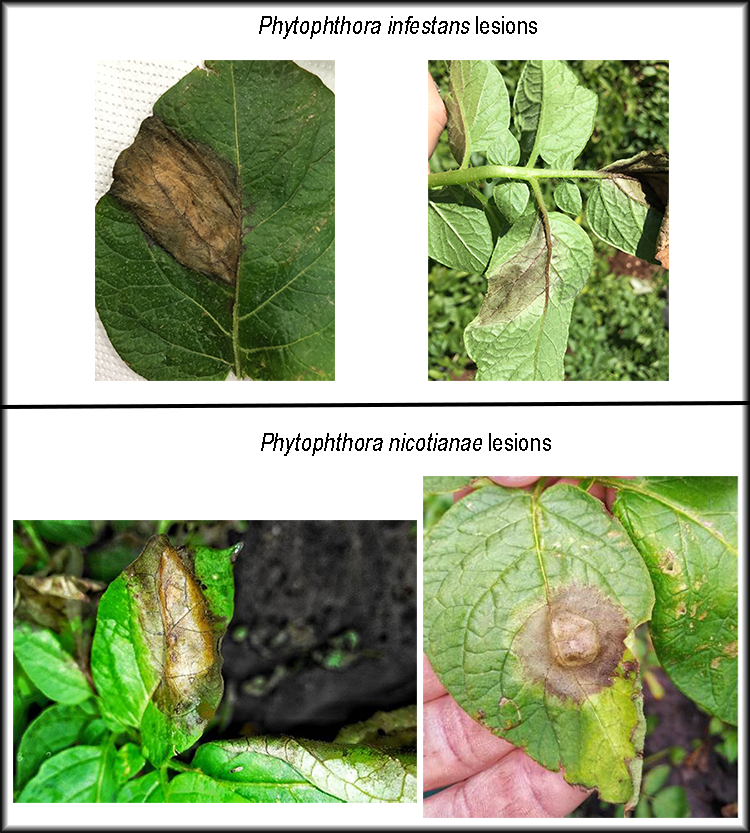This article appears in the September 2018 issue of Potato Grower.
*The article originally stated that no P. infestans had been reported in North Carolina in 2018; it has been updated to reflect developments later this growing season.
Due to the run of warm, wet weather in the Southeast this summer, conditions were ideal for the development of late blight (caused by the pathogen Phytophthora infestans) on potato and tomato crops. Extension potato specialists received samples exhibiting late blight-like symptoms on tomato and potato. However, further evaluation of these samples has shown that these infections on both tomato and potato were caused by a related species, Phytophthora nicotianae. While normally a soil-borne pathogen, the presence of foliar lesions indicates that the pathogen has also spread aerially. In eastern North Carolina, severe foliar infections have been observed. The severe wet weather and high temperatures were highly favorable for the pathogen that, unlike P. infestans, is most severe under cool weather conditions.
“Late blight was reported in western North Carolina on Aug. 20 and was confirmed as the US-23 lineage. The disease has also been reported in other eastern states, including Florida, New York, Pennsylvania and Maryland.
P . nicotianae, on the other hand, was detected early this season on both potato and tomato crops in North Carolina. P. nicotianae differs from P. infestans in several ways. While both pathogens can infect foliage and tubers, P. nicotianae is primarily a soil-borne pathogen and can infect plant roots. It also has a broader host range than P. infestans and the ability to generate overwintering survival spores including oospores and chlamydospores in the soil. Foliar infections of P. nicotianae resemble symptoms associated with late blight, including large, water-soaked lesions on leaves and stems. This year, foliar blight was severe on potato; tuber rot has also occurred. P. nicotianae lesions generally do not exhibit sporulation. Due to the tendency of P. infestans to sporulate heavily, lesions caused by P. infestans may show a whitish halo on the underside of the leaf where spores can be observed under a hand lens, but this is not present in all infections.
. nicotianae, on the other hand, was detected early this season on both potato and tomato crops in North Carolina. P. nicotianae differs from P. infestans in several ways. While both pathogens can infect foliage and tubers, P. nicotianae is primarily a soil-borne pathogen and can infect plant roots. It also has a broader host range than P. infestans and the ability to generate overwintering survival spores including oospores and chlamydospores in the soil. Foliar infections of P. nicotianae resemble symptoms associated with late blight, including large, water-soaked lesions on leaves and stems. This year, foliar blight was severe on potato; tuber rot has also occurred. P. nicotianae lesions generally do not exhibit sporulation. Due to the tendency of P. infestans to sporulate heavily, lesions caused by P. infestans may show a whitish halo on the underside of the leaf where spores can be observed under a hand lens, but this is not present in all infections.
Potato and tomato crops with late blight-like lesions should be carefully checked due to the presence of P. nicotianae, particularly in the Southeast. Samples may be submitted to local extension agents or crop consultants for further analysis.
P. nicotianae does not spread as rapidly across fields as P. infestans due to lower production of sporangia, but adopting a late blight spray program following label recommendations will help manage both pathogens. Consult the control recommendations on the late blight fact sheet or the 2018 Southeastern U.S. Vegetable Crop Handbook for more information on recommended compounds and spray schedules.
It is highly encouraged that samples suspected to be late blight are submitted for genotyping by following instructions on the USABlight website. The disease alert and surveillance system also includes additional information on control methods and a decision support tool for fungicide spraying.
|
|
P. infestans
|
P. nicotanae
|
|
Mefenoxam sensitivity
|
Dominant lineage US-23 sensitive to mefenoxam
|
Mefenoxam resistance reported
|
|
Disease cycle
|
No soilborne phase
|
Soil oospores and chlamydospores
|
|
Mating types
|
A1 (US-23) dominant; no oospores currently reported in U.S.
|
A1 and A2 common; oospores present
|
|
Symptoms on potato
|
Tubers, stems and foliage
|
All parts of plant, including roots
|
|
Asexual survival stages
|
None
|
Chlamydospores
|
|
Host range
|
Narrow: potato and tomato
|
Wide: potato, tomato, citrus, tobacco, ornamentals
|